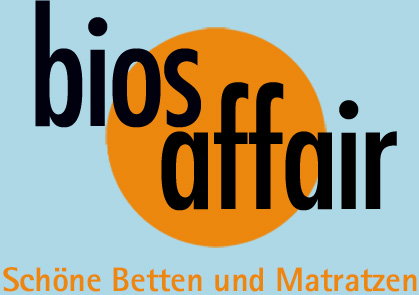Healthy lying – dynamic lying
Fundamental considerations for “healthy lying” – based on the Feldenkrais theory
1. health is a life process – not a consumer article
2. life means movement – sleeping also
3. the learning ability of the human nervous system
4. restructure the body – or get lost in the mattress
5. the theory of the intervertebral discs-correct mattress
6. the weak points of the spine.
1. Health is a life process – not a consumer article
When buying a mattress, the question naturally arises as to whether there are certain health criteria to consider when choosing a mattress. Because today there is hardly anyone who has not been affected by back pain in any way.
Even if you do not make any special demands on a mattress at first, except that you want to feel comfortable and sleep well on it, it is not easy to make a decision with the variety of the offer. Some suppliers emphasize the quality of their materials, others a special processing technique, others special functions. And everyone praises their mattresses as healthy. In order to increase credibility, the sellers try to justify their statements scientifically.
However, in classical medicine there are few indications as to how the human body organizes itself when lying down, or how the spine stretches when lying down, and how the organs rearrange themselves in the connective tissue.
Irrespective of this fact, the mattress suppliers simply claim that it is all about relieving the spine and that there must be appropriate support zones. In addition, there are terms such as “intervertebral disc-compliant” or “orthopaedically correct” to give the assertion medical authority.
If one looks through the publications and presentations of the well-known mattress manufacturers under these conditions, one comes to the surprising conclusion that at present there is not one supplier who includes the dynamics of the human musculoskeletal system in his argumentation.
Mattress manufacturers obviously know neither anything about the ability of the nervous system to integrate nor about the connection between “tonic” muscle activity, arbitrary muscle activity and relaxation (see note below).
We can easily assert this, because knowledge of the dynamic functions of the human “musculoskeletal system” would result in a completely different appearance. Dealing with the neuromuscular organization of the body leads to the insight that the body is basically very flexible and much more willing to change and adapt than is generally assumed. And this insight leads to a completely different lying concept.
The conventional method of counselling for back problems is well known: One responds to people by confirming their orientation towards their suffering, while on the other hand one strengthens the belief in the fixedness and increasing stiffness of the body. In tune with this disease perspective, it is more or less self-evident to buy a particularly supportive, “orthopaedically correct” mattress, as recommended.
The concept of dynamic lying, on the other hand, draws people’s attention to their liveliness, their mobility and their possibilities for change. We (as mattress suppliers) do not and cannot pretend that health can be bought or consumed. Health is nothing external and can best be described as a process in which the human being is involved inwardly and actively. The consequence of this is that the bed comes in second place during the consultation and the person in first place.
Note:
The “tonic” or “anti-gravity muscles” align the body against the earth’s gravitational field, controlled by the autonomous nervous system. The “arbitrary” and “conscious” muscle activities often overlay this natural alignment process. And this in turn usually happens completely unnoticed, because many muscle activities elude consciousness through habituation. Thus, hardly anyone knows that all emotional impulses are connected with patterns of muscle excitation.
2. Life is motion – sleeping also
When we say that people come first, we mean that we can hardly sell a “healthy” bed if we do not take seriously those people who are also looking for a solution to their back problems when buying a bed. Because we know that the complaints cannot be eliminated by a new bed, since they probably did not arise from the previous bed either. But if you change your movement behaviour, a correctly selected mattress can help to support the stimulated restructuring processes. However, we do not only want to point out such general contexts to our customers, but, as far as possible, give them concrete suggestions and practical assistance.
2.1 Support through “back prostheses”
The different approaches to the topic of “lying and sleeping” are an expression of a different view of life. We want to illustrate this in the comparison. It seems that most mattress suppliers understand the human being as a being who has not really coped with the development to an upright human walk. Therefore, according to the opinion, the allegedly overloaded spine must be treated gently and relieved. One could think that the mattress salesman is faced with the question that a packaging technician has to answer for a figure with irregular shapes: in the side view the buttocks arched backwards, in the front view the shoulders protruding laterally and the curved pelvis. “In terms of packaging, of course, this is not a problem: recesses (“e.g., shoulder sinking”) must be created in the shoulder and pelvis area, while the figure’s slimmer waist requires a lining (“lumbar support”).
The philosophy of most bed and mattress manufacturers is not only based on similar considerations, it also comes to the same conclusions without taking into account the difference that this is the bedding of a living, dynamic and very adaptable organism whose inner nature is determined by movement.
2.2 Development of body feeling
Our dynamic approach is based on the Feldenkrais method (see below) and is based on the experience that the “everyday phenomenon of back pain” is not a static problem caused by developmental history, but a cultural one. Already in childhood a process of exclusion of movement possibilities begins – because only a few are selected and learned from the variety of possible posture and movement patterns. As a result, there are no alternatives available to adults when discomfort occurs. But he needs them if the accustomed and retracted movements cause problems. Then he has no other choice but to remain or to continue in the old manner and to suffer from it. In this way, the problems will increase until serious damage may occur.
The dynamic approach, on the other hand, aims to open up new approaches for people when interacting with their bodies. It’s about learning to do the everyday and self-evident movements, i.e. what you already know, in a different way. This is the only way to permanently release unnecessary tensions and avoid new “dead ends” (i.e. movement bottlenecks). An important prerequisite for this is the sensitive and differentiated perception of one’s own body.
2.3 What visitors can expect from us
We would like to pass on the theoretical and practical experience we have gained in working with the subject of “lying, physical organisation and mattresses”. For example, we advise our customers to take so much time on the individual mattresses that the extensor muscles of the back can loosen. Only then will the sensitivity for a more precise assessment be able to emerge. We would like to continue to show our customers how they can move during the mattress test lying, the frequent standing up and lying down, without unnecessarily straining the cervical and lumbar spine. We also want to help analyse complaints associated with certain positions in order to find alternatives to the usual treatment of problems.
Those who take enough time and rest to test lying down, and with a little patience and attention develop a perception of the differences, will quickly become aware of their body’s focal points and sensitivities. He may discover that the contours of the back change through the attentive perception and sensitization of the body, and that the need for support is a relative matter. The back does not always remain the same, what is perceived as pleasant today may be painful tomorrow and vice versa. It is the person himself who can take possession of his back again and change himself and not the bed.
3. The learning ability of the human nervous system
3.1 The idiosyncrasy of lying – the opposite of standing.
Standing, that means the alignment of the body against gravity. Since head, neck, chest, pelvis and legs are arranged one above the other, the weights add up from top to bottom. The deeper a part of the body is positioned, the more load it has to bear. When lying, on the other hand, each part of the body only has to bear its own weight. Lying down is not “standing in a horizontal position”, but it means a completely different organization of the body than standing up. Z. B. the head takes a different position to the cervical spine, the shoulders sink and the S-curve of the spine becomes flatter while the pelvis opens slightly. (see illustration). This also results in a different relationship between muscles, ligaments, connective tissue, bones and organs. Even if most of the muscles that hold the body upright against gravity are now relieved, this does not mean that all muscles are relaxed.

Standing man in a horizontal position
A standing person turned horizontally (above) in comparison to the orientation of the body of a lying on solid ground (below). You can see that the body aligns itself differently and clings to the contact surfa

Reclining person on a solid ground
Accustomed patterns of muscle tension, which combine with inner attitudes, continue to determine the body. These very personal tensions, which have almost become second nature to man, are only gradually released during sleep. And this happens through movement. But there are also other movement impulses that occur during sleep, e.g. reactions to dreams, to strong tensions and emotional impressions of the previous days.
Lying and sleeping are not only forms of letting go, but also forms of balance, combined with biological-organic processes: The body stretches itself, it collects and restructures itself. The goal of “dynamic lying” is to stimulate and support these processes. This includes a certain way of using the body as well as a certain conception of bed and mattress.
3.2 The organic function of the “musculoskeletal system”
Today’s common back pain, which affects many adults, has no extraordinarily characteristics except that it is not necessary. They come to light as a result of overloads at organic weak points. As already described above, the causes lie in the culturally determined one-sidedness of the movement sequences and in the restriction of the variety of movements under the influence of stress and psychological tension. The typical posture of every person is the result of the development and habituation of individual patterns of movement and feeling. However, the embodiment of personal behavior that has grown in this way is not an inevitable fate, even if these patterns are so familiar that they appear as a natural part of oneself.
Our optimism regarding the possibilities of change of the human body lies in its biological-organic structure and the almost unlimited ability of the nervous system to integrate. The reason for the solidification of the body structures is not the rigidity of the bone structure, but the entrenched and limited interaction of muscles and nervous system. And this connection is basically open and can be influenced!
The human nervous system has the unique ability to restructure itself again and again through individual experiences and to establish new nerve connections. This is also the reason for the ease with which people (regardless of age) can learn.
It is well known that the physical posture is structured by the nervous system. But it is hardly known that the nervous system and thus the anatomy of posture can be reorganized through alternative movement experiences. This is the significant discovery of Moshe Feldenkrais. “Awareness through movement”, as Feldenkrais calls his method, is organic learning in which one can experience the fundamental variability of the physical structure. Learning according to this method takes place through light, playful movements, without goal-orientation and pressure to perform. In the process, the simplest movement sequences, which otherwise escape perception through their everydayness and self-evidence, are rediscovered by imparting functional alternatives to the “curious” nervous system, which is always ready to learn. This learning is as direct and natural as the tasting learning of a small child, only that one is aware of what one is doing and thus experiences an undreamt-of wealth of changes.

Well coordinated horizontal spine of a standing person
A well-balanced spine of a standing person turned horizontally (top). In a lying person, the body is stretched so that the curve of the spine stretches accordingly
and becomes flatter.

Shape of the spine on a soft mattress
A position of the body as shown in the picture below (praised as ideal by one of the leading mattress manufacturers) causes the body to sink deeply into its centres of gravity, so that the spine bends even more instead of stretching. The weight of the buttocks pulls the pelvis downwards, creating a corresponding counterpressure in the cross that makes it impossible to stretch the spine.
4. Restructure the body or lose it in the mattress
The “organic way” and the “mechanic way”. | ||
| Dynamic relaxation | Static unloading | |
| Recovery is a process, complete absence of tension, on the other hand, means standstill. The recovery process is initiated by relief and movement. This is a complex interaction between muscles, ligaments, connective tissue and the central nervous system. | oriented towards the fiction of “anatomically correct positioning”, the “bio-mechanically” oriented designers try to create a systematic relief. The body should sink so deeply into the mattress that it is evenly supported point by point. | |
| Movement in sleep | Passiveness | |
| Not only the recovery processes of the vegetative organism take place during sleep. The musculoskeletal system is also endeavouring to reorganise itself. And a reorientation of the muscular processes is not possible without movement. The mattresses, which are manufactured according to the concept of “dynamic lying”, support this natural flow of movement and motivate the body to stretch and loll. | The consistently soft, point-elastic positioning has the effect that the body “lifts off” the “floor” and in a way starts to swim. For a sensitive doll this would surely be an optimal storage, because it cannot bump anywhere. For a living organism, however, this lack of ground contact is not very beneficial. The “musculoskeletal system” experiences itself as if it were trapped and is condemned to passivity. | |
| Postive feedback | Disorientation | |
| This means: perceiving the body and giving it orientation. The clearer the contact with the pad is, the easier the body can organize itself. A relatively firm and even base gives the body a clear feeling of its contours and centres of gravity. The base acts as a mirror for the nervous system. | On a soft, foamy mattress, the feeling of the body’s boundaries is blurred and with it the body’s orientation possibilities disappear. The body “loses” itself in the mattress. In this way, he has hardly any possibilities to reorganize himself and, in turn, to cling to the base. | |
| Momentum | Immobilization | |
| The concept of “dynamic lying” is based on the experience that the back and the body as a whole restructure during the night. This leads to the insight that the need for support is a relative matter, depending on the daily burdens and the ability to detach from them. | Under these conditions, the back has no incentive to stretch and hardly has the chance to do so. Even if the large psoas muscle between the lumbar vertebra and femur relaxes sufficiently, the cross cannot stretch because it is fixed by the mattress as a result of the support. | |
| –––– | ||

Strongly supported back
The spine is held in position by the support and cannot stretch, even when the large psoas muscles (between the lumbar vertebrae and thigh bones) have relaxed.

Lying person with stretched spine
On firm ground: The spine can stretch, as soon as psoas and back extensors loosen.
To avoid misunderstandings, we would like to emphasize that the concept of “lying healthy – lying dynamically” does not mean foregoing support for the back. Rather, it is only a matter of not giving the back more support than it needs, but also no less. Too much support blocks the process of re-structuring, whereas too flat a positioning may cause pain under certain circumstances, e.g. in the case of severe tension or a pronounced hollow back. Although pain is often part of a healing process, when it exceeds the tolerable level, the tense muscle strands harden and also prevent the re-structuring process.

Back relief position
In this position, the muscles cannot exert any tension on the spine, so that the lumbar vertebrae can stretch without restriction. In this position an effective back exercise can be performed. However, you will have to lie on the floor. Then press the heels into the ground so that the pelvis rolls slightly towards the head (the coccyx rises). Then let go and roll the pelvis towards your feet (the coccyx tends to the floor). This exercise is also called pelvic swing, it promotes the harmonization of the spine. The effect can be increased even more if you let the rocking movement slowly change in diagonal direction, first to one side, then to the other.
This exercise should be performed without force, slowly, gently and with attention.
5. The theory of the “intervertebral discs compliant” mattress
As already mentioned, there is a very common model that is supposed to be proof of the concept of the “orthopaedically correct mattress”. It is about the image of a woman lying on her side, turning her back to the viewer and demonstrating her dead straight spine. (See illustration) A story is told about the intervertebral discs that suggests that there is a patent solution to the widespread back problems.
Intervertebral discs are elastic, water-binding buffers that are mounted between the individual vertebrae like hydraulic presses. Due to the stresses of the day, the intervertebral discs lose a part of their fluid, while they accumulate again at night. The story now tells that the intervertebral discs can only fill up again on the mattresses in which the spine aligns itself straight, and that any other alignment hinders this process and is therefore unhealthy for the back.

The so-called spinal disc protection position
5.1 The Movement-therapeutical answer
If this theory were correct, it would mean that one should beware of bending the torso more often during the day in order to retain sufficient reserves of intervertebral disc fluid. It would also mean that before these mattresses existed, all of humanity slept with damaging effects on its back.
However, the strain on the intervertebral discs generally results from the upright posture of the human being, in which the spine has to carry and balance the entire weight of the upper body. As soon as the body is horizontal (i.e. lying down), the intervertebral discs can refill. (x) Slight turns and flections of the spine are quite natural and do not hinder their regeneration. The transport of intercellular fluids is even supported by changing the lying position from time to time. Of course, the alignment of the spine also changes each time.
Irrespective of this, there is probably no person who will take up the special lateral position depicted all night long. She is rather unstable because of the stretched, superimposed legs and beyond that still stiff and uncomfortable. Most people will bend their legs a little and push their shoulders towards the head or pelvis, moving them slightly backwards or forwards in order to snuggle better against the base and distribute the weight (as shown in the figure below).

Natural relaxed sleeping position
(x) In an experiment at the University of Ulm, a measuring electrode was implanted into the intervertebral disc of a living human being to measure the pressure in various postures and lying down positions. It was found that the pressure in the intervertebral disc is independent of how the spine is aligned while lying down. A more detailed description of the experiment can be found here.
6. The weak points of the spine
Why do most complaints occur in the cervical and lumbar spine? In everyday life with little movement, the mobility of the shoulder girdle, thoracic spine and pelvis “rust”, i.e. adhesions are formed from a spongy, fibrous tissue. Due to this stiffening, all rotational movements finally only occur via a few cervical and lumbar vertebrae. These are finally overstrained by the heavy permanent load, as are the intervertebral discs stored in between. The “healthy lying – dynamic lying” concept recommends exercises that enable the nervous system to distribute loads and turns over the entire length of the back. The mobility of the spine can be regained so that a continuously flowing connection between head and pelvis is established.
6.1 Small steps improve well-being
In many cases, help can be achieved by very simple steps, e.g. in case of back pain, as far as these are caused by tensions and overloads (with a pronounced hollow back). Sometimes it is sufficient to take up the lateral position and to bend the legs in order to bring the body back into harmony by forming a “round back”.
There is not only one, but many “correct” lying positions, and often existing tensions can be compensated by conscious, sensitive changes of position. In addition, there are simple, effective movement exercises for almost every problem, which we would be happy to arrange for you during your personal consultation.
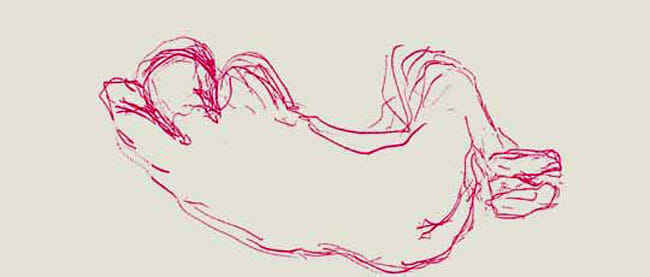
Round back
The back muscles are stretched and the large psoas muscles are relaxed. If this is not enough, we recommend that you place a small roll of about 6 to 10 cm in diameter (e.g. a rolled up bath towel) between your bent knees. Then gently and carefully push the upper leg on the roll back and forth for some time. If you then repeat this exercise on the other side, you will soon feel a relief in your back.
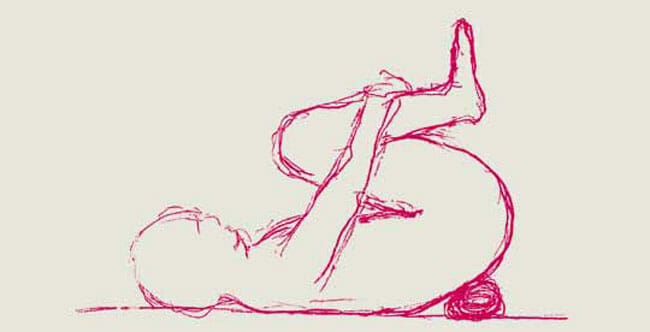
Exercise with the pelvic roll
Simple exercise to bend the cross the other way around: Form a blanket into a roll about 8 cm thick. Then lie on the floor, place your legs at an angle and push the roller transversely under the pelvis. If you now pull your legs firmly to your chest with your hands, you will experience the healing effect that the aching lumbar vertebrae bent downwards and that the sensitive cervical vertebrae also nestle firmly against the floor
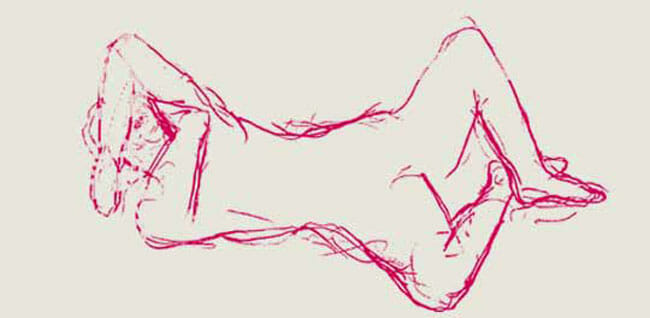
Twisted, entangled lying position
An unusual and twisted body position can also contribute to harmonisation. The “favourite position” of some people often arises from a natural need for compensation. Try to intensify or exaggerate your favourite position on purpose. They give the muscles the opportunity to let go.
6.2 Don’t forget your head
The other critical point in the course of the spine is the transition from the head to the trunk. Specially shaped support cushions made of foam have recently been promoted for the widespread tension in the neck muscles. However, firmly formed and strongly supporting cushions have the disadvantage that they hinder the mobility of the head. Yes, the head may not move at all, because all other positions than those given by the form are uncomfortable. In order to allow rotation, the head must also be raised slightly, which in turn puts a strain on the cervical spine. However, we do not believe that neck support should be dispensed with. Mouldable cushions made of buckwheat, spelt or millet husks, for example, offer optimum adaptation. These cushions allow a good support of the neck without restricting the mobility of the head. The shape of the pillow is self-evident: By moving the head, the shells slide into the desired position. Unlike foam and springs, the shells allow flexible adjustment without exerting pressure. The strength of the cushions also prevents the head from gradually sinking into an unpleasant position.
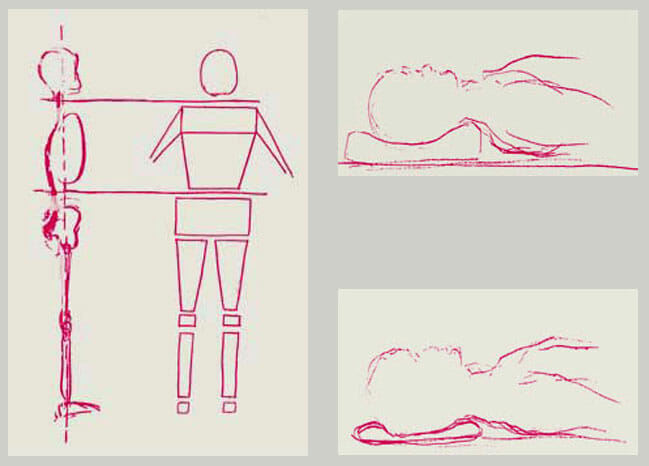
The blocked person (Ida Rolf)
Left figure: The blocked person
Due to the stiff shoulder block, the rigidly held thorax and the motionless pelvis, the rotation of the spine is reduced to two areas, which become problem areas.
Illustration top right:
Head and cervical spine (on a shaped foam cushion) are held in the ideal position by the cushion. The movement of the head can only take place via one or two cervical vertebrae and therefore has an even more strenuous effect.
Illustration bottom right:
Variable support by a cushion filled with bowls. The shells can be moved freely by head movements and adapted to the neck.
Bibliographic references
For further information, please contact us. Upon request, we will be happy to provide you with the addresses of Feldenkrais teachers in your area. Instructions for simple exercises are described in the book “Leben ohne Rückenschmerzen” from Ruthy Alon, published by Junfermann Verlag, Paderborn 1993. Detailed explanations of the method can be found in the writings of Moshe Feldenkrais: “Bewußtheit durch Bewegung”, Suhrkamp, paperback st 429, Ffm 1978 “Das starke Selbst” Suhrkamp, paperback st 1957, Ffm 1992 “Die Entdeckung des Selbstverständlichen”, Suhrkamp, paperback st 1440, Ffm 1987 “Die Abenteuer im Dschungel des Gehirns”, Suhrkamp, paperback st 663, Ffm 1981 “Der Weg zum reifen Selbst”, Junfermann Verlag, Paderborn 1994 “Die Feldenkrais Methode in Aktion”, Junfermann Verlag, Paderborn 1990
Contact to Feldenkrais teachers (information and addresses) can be found at www.feldenkraisnetwork.de and at www.feldenkrais.de
As the most important corresponding methods to that of Moshe Feldenkrais, we would like to refer to “Rolfing” and to “Structural Integration” according to Ida Rolf (information and contact www.rolfing.de) and on “Eutonie” by Gerda Alexander (Information and contact at www.eutonie.de).
